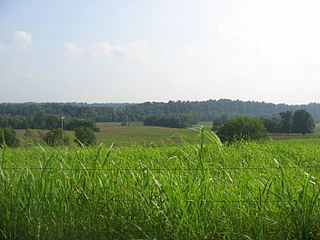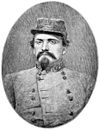
The Battle of Tebbs' Bend was fought on July 4, 1863, near the Green River in Taylor County, Kentucky during Morgan's Raid in the American Civil War. Despite being badly outnumbered, elements of the Union army thwarted repeated attacks by Confederate Brig. Gen. John Hunt Morgan's dismounted cavalry.

The Confederate Monument of Bowling Green, in Bowling Green, Kentucky, is among the sixty-one monuments of the Civil War Monuments of Kentucky Multiple Property Submission, all of which became part of the National Register of Historic Places on July 17, 1997. It is within Bowling Green's Fairview Cemetery, on the east side of the old/northern side of the cemetery.

The Confederate Monument in Cynthiana is located on the outer edge of Cynthiana, Kentucky in Battle Grove Cemetery. It was the first monument to the Confederate States of America dedicated in the State of Kentucky, and long believed to be the first Confederate memorial anywhere. Due to the 32nd Indiana Monument having been moved from its original location, the Cynthiana monument is the oldest Civil War monument still standing at its original location, where the second Battle of Cynthiana started, in the then-new town cemetery.

The Confederate Monument in Glasgow, Kentucky, built in 1905 by the Kentucky Women's Monumental Association and former Confederate soldier John A. Murray, commemorates those who gave their lives in service for the Confederate States of America. It is located on the side of Glasgow's courthouse. The Confederate soldier, made of bronze, is at parade rest, and features details such as a bedroll, canteen, kepi hat, and rifle. It stands on a limestone pedestal.

The Confederate Monument in Harrodsburg, located at the entrance to Spring Hill Cemetery in Harrodsburg, Kentucky, is a statue listed on the National Register of Historic Places. It depicts a life-sized older Confederate cavalryman standing ready.

The Confederate Monument of Morganfield, Kentucky is a monument to Confederate soldiers from surrounding Union County, Kentucky, of which Morganfield is the county seat. It is in the northernmost corner of the City Cemetery/Odd Fellows Cemetery just outside downtown Morganfield. During the War "Union" County was mostly a Confederate-sympathizing county. The county produced 657 soldiers for the Confederacy, but only 187 for the Union, although 131 African-Americans joined the Union forces in 1864. In July 1862, Union forces at Caseyville, Kentucky threatened to arrest everyone in the town of treason, eventually freeing all but nineteen citizens. A skirmish in Morganfield on September 1, 1862, resulted in a Confederate victory.

The Colored Soldiers Monument in Frankfort, Kentucky's Green Hill Cemetery, at the junction of US 60 and US 421, is the only Kentucky monument honoring black soldiers that participated in the American Civil War, and one of only four in the entire United States. Erected by the Woman's Relief Corps No. 8, an auxiliary of the Grand Army of the Republic, it was unveiled on July 4, 1924. The only other monument built by GAR in Kentucky is the GAR Monument in Covington.

The Confederate Monument in Danville, originally located between Centre College and the First Presbyterian Church at the corner of Main and College Streets in Danville, Kentucky, was a monument dedicated to the Confederate States of America that is on the National Register of Historic Places. The monument was dedicated in 1910 by the surviving veterans of the Confederacy of Boyle County, Kentucky and the Kate Morrison Breckinridge Chapter of the United Daughters of the Confederacy (UDC). In 2021, it was relocated to a museum in Meade County, Kentucky.

The Confederate Memorial Fountain in Hopkinsville, Kentucky is a monument dedicated in October 1911. It is on the National Register of Historic Places.

The Unknown Confederate Dead Monument in Perryville is located in the vicinity of Perryville, in Boyle County, Kentucky, United States, in the Goodknight Cemetery, a small family cemetery on private land. It is presumed to have been constructed around the year 1928, sixty-six years after the Battle of Perryville on October 8, 1862, in which the Confederate soldiers buried here anonymously died. In total, 532 Confederates died at the battle, but it is unknown how many of this number are buried here.

The Confederate Monument in Perryville is a historic monument located by the visitor center of the Perryville Battlefield State Historic Site, in the vicinity of Perryville, Kentucky, in Boyle County, Kentucky, USA. It was built in 1902, forty years after the Battle of Perryville, the bloodiest battle in Kentucky history, on October 8, 1862. In total, 532 Confederates died at the battle, but it is unknown how many of this number are buried here. A small cemetery is by the monument; local farmers had to bury the Confederate dead as the Confederate Army, although victorious in the battle, had to leave Perryville quickly, and hogs were beginning to feast on the soldiers' remains.

The Union Monument in Perryville is an historic monument located by the visitor center of the Perryville Battlefield State Historic Site, in the vicinity of Perryville, Kentucky, in Boyle County, Kentucky. It was built in 1928, sixty-six years after the Battle of Perryville, the bloodiest battle in Kentucky history, on October 8, 1862. There were 16,000 Union soldiers at the Battle of Perryville, with 4,276 combined killed, captured, wounded, and missing.

The Confederate Memorial in Mayfield is a commemorative monument and fountain located on the courthouse lawn in downtown Mayfield, Kentucky.

The Confederate Memorial in Nicholasville is a historic statue created in the Jim Crow era and located on the Jessamine County courthouse lawn in Nicholasville, Kentucky, ten miles south of Lexington, Kentucky.

The Confederate Monument in Owingsville in Bath County, Kentucky, near Owingsville, Kentucky, commemorates the Confederate soldiers who hailed from Bath County. It is located in Owingsville Cemetery.

The Confederate Monument in Bracken County, Kentucky, in Augusta, Kentucky, honors eight unknown Confederate soldiers who were killed attacking Augusta in September 1862. Confederate Colonel Basil W. Duke led a force of Confederate soldiers to raid the town, on September 27, 1862, only to be driven back by a home guard force numbering 100 and backed up by gunboats. Eight Confederate soldiers of the 21 who died were buried in Payne Cemetery. In 1903 the present monument was placed at their burial spot.

The Union Monument in Vanceburg in Lewis County, Kentucky, in Vanceburg, Kentucky, commemorates the Union soldiers of the American Civil War. It is the only monument anywhere south of the Mason–Dixon line that so honors Union soldiers that is not in a cemetery done by public subscription.

The Confederate Monument in Crab Orchard in Lincoln County, Kentucky, near Crab Orchard, Kentucky, commemorates the fallen Confederate soldiers of nearby states. Many of those buried here died at the Battle of Wildcat Mountain.

The Battle of Dutton's Hill Monument in Pulaski County, Kentucky, near Somerset, Kentucky, commemorates the Confederate soldiers who died at the battle of Dutton's Hill in 1863.

The General Felix K. Zollicoffer Monument in Pulaski County, Kentucky, near Nancy, Kentucky, commemorates the death of Confederate Gen. Felix K. Zollicoffer, who died here at the Battle of Mill Springs. A native of nearby Tennessee, he fought for the Confederacy. Zollicoffer was killed due to not realizing he was approaching Union lines instead of the Confederate line.

























